NASCAR's EFI: technological triumph, or good money wasted? Let's ask McLaren
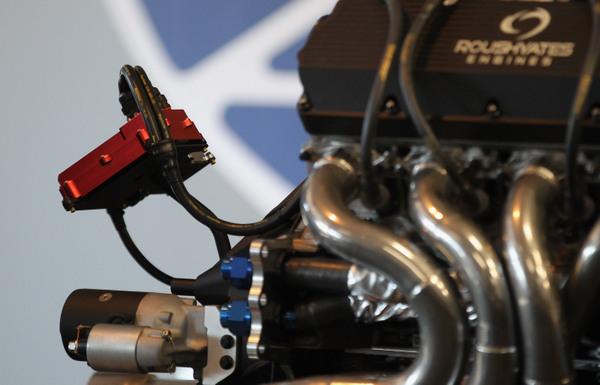
NASCAR-McLaren: the $11,250 engine EFI cpu. Pretty, but does it make the racing better? Greg Biffle, atop the Sprint Cup standings, would vote yes (Photo: Getty Images for NASCAR)
By Mike Mulhern
mikemulhern.net
TALLADEGA, Ala.
Not sure what Bruce McLaren would think about this NASCAR thing today.
Heck, more than one in the stock car garage may have a few questions too about the shape of things, and what the future might bring, even in Sunday afternoon's Talladega 500/Aaron's 499.
But over here in the far corner of the garage, down past the start—and-parks, and beyond the curious incarnation of once-venerable race parts suppliers Butch Stevens and Dick Hutcherson, and beyond the mobile UPS office, and beyond the bevy of team grillers smoking away at lunch meals – is the latest addition to the NASCAR scene...and the latest piece of the world-renowned, and world-wide giant racing operation created by the New Zealander before his death in a 1970 Can-Am crash.
McLaren.
Doing just what, out of this slick, metallic-bronzed trailer?
EFI.
At least.
In the first few weeks of the NASCAR EFI project, this McLaren office-on-wheels has held quite a mystique, seen by some as something of a NASCAR DARPA, working with the dark arts of computer science. Even Jimmie Johnson was asking questions.
And Dale Earnhardt Jr. has warned of his feelings that this EFI thing could change this sport in worrisome ways.
Earnhardt wasn't very forthcoming with specifics about his worries, though maybe he was considering the possible ramifications of McLaren's turn-key Formula 1 project with Force India. Wonder what team owners might think if McLaren, or some other racing-tech giant, might decide to offer a similar turn-key team project here in NASCAR....
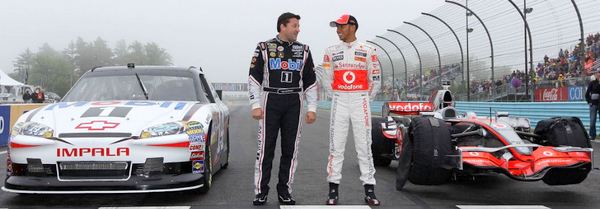
Tony Stewart (L) and F1-McLaren's Lewis Hamilton, trading cars last summer at Watkins Glen (Photo: Getty Images for NASCAR)
Whatever this NASCAR EFI project is, or leads to, this non-descript rolling office is headquarters.
EFI is a quantum leap for NASCAR.
This isn't a Bill Gazaway show anymore, where rules are just eyeballed. Not by a long shot.
It's even a far cry from the radical technological changes Cal Wells, then a fledging Cup team owner, unleashed when in 2000 he brought in a crew armed with half a dozen laptops. NASCAR execs were so downright frightened by Wells' tech invasion they put in severe – and now clearly nonsensical – limits on what his men could do with those laptops.
Now some, maybe even many, might question why NASCAR executives discarded those inexpensive, easy-to-police carburetors and shoved this expensive electronic fuel injection setup down every Sprint Cup team's throat, and told drivers and crews not to criticize this project, at the risk of heavy fines.
Is this EFI just a gross waste of money, with no obvious visual benefits to the fans in the stands or in front of their TVs?
Just another marketing game with nebulous payoff?
Come to think of it, where is the NASCAR-McLaren-EFI marketing? Where are the ads?
Is this just another example of expensive barriers to entry into this sport for anyone inclined to try his hand at running a race team?
This sport sure has changed since the days when Richard Childress hauled his entire team around the country in a dually, dragging that one race car in a Chaparral.
And it's changed a lot since Andy Petree hired Terry Satchell as one of this sport's very first engineers...to the hoots and hollers from skeptical rivals.
Nobody's skeptical about engineering in NASCAR anymore...except maybe team CFOs and increasingly discouraged fans in the stands who this season have been asking where's the beef.
Wonder what Alan Kulwicki would say about this EFI thing? Or maybe he'd have a better way....
Is there anyone in this sport who can give us an unbiased, unvarnished explanation, without risking NASCAR's wrath?

Robby Gordon: EFI problems at Bristol -- car wouldn't even start. Then he suddenly drops off the NASCAR tour (Photo: Getty Images for NASCAR)
After Mark Martin, Joey Logano, Tony Stewart, Robby Gordon, Brad Keselowski and AJ Allmendinger all had significant problems with EFI systems at Daytona, Phoenix, Las Vegas and Bristol, the questions became more pointed.
After Gordon's car failed even to fire up at Bristol pre-qualifying, forcing him to pack up and leave, Gordon reassessed things in NASCAR and decided to take a long sabbatical. And he's still out somewhere in the desert.
Just what is going on here?
Of course engine techies may love all the neat tricks and tweaks they can now play with, with this EFI stuff. And, just as with any new technology, teams certainly aren't going to be very outgoing with what they do know, or don't know, unless it's obvious – like Keselowski going behind the wall with EFI issues of some sort, or Stewart stalling on the track at Phoenix.
And it doesn't help that those in the dwindling corps of NASCAR journalists seldom venture this deep into the garage to ask questions.
But is all this simply a tempest in a teapot, much ado about nothing?
Should we all just 'shut up and write'?
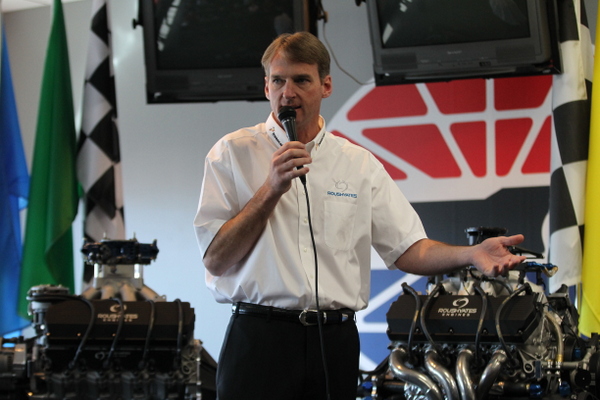
Doug Yates, engine designer extraordinaire, and two of his league-leading EFI creations (Photo: Getty Images for NASCAR)
Okay, let's knock on the door and see who's inside.
First, a little background:
American racing, NASCAR and Indy-car at least, is in one of those fitful phases, that seem to come along every five or six or 10 years.
One question at the moment is just how relevant is NASCAR racing itself anymore.
Is American society, or key segments, simply getting bored with this stuff?
(Certainly it doesn't help things when the racing out on the track is as boring as it's been lately, whether that's because these drivers are too fat and rich and not hungry enough anymore, or because these cars have become so high-tech and expensive that NASCAR racing seems little more than some engineering exercise, a modern-day battle of the slide rules.)
Maybe the American audience for sports in general has become satiated. How many ESPN channels does it take to fill a sports bar anyway?
Plus, it has become clear that today's sports world is unique in that it features a seemingly sudden demographic chasm in U.S. society, with the generation dubbed the Millennials, those from about 18-30, increasingly less interested in cars at all.
Remember the classic America Muscle Car era, circa 1969, with hot Mustangs and Camaros and 442s and 427s. Such ancient history that only an aficionado of the Barrett-Jackson channel can appreciate.
The company line is EFI may help the sport of NASCAR racing become more relevant to a younger audience. And this may all be coming at the behest of Detroit itself, which has been spending millions of dollars for years in NASCAR, with little 'identity' except for logos and decals.
Can EFI, and Travis Pastrana, help save NASCAR?
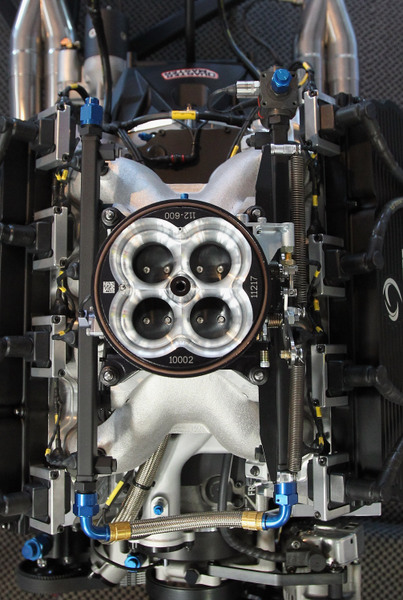
No shade tree creation this (Photo: Getty Images for NASCAR)
Cue Cameron Kerr.
One of the NASCAR-McLaren 'support engineers,' along with teammate Thomas Andrews, keepers and minders of those trendy new bright red EFI computers that sit so prominently now atop these Sprint Cup engines.
Andrews came over from the sports car side of the sport, working with the engineering design company Mo-Tech. Kerr himself (B.S, physics, USF) has been an engineer in NASCAR for 10 years, working his way from All-Pro, Hooters Pro Cup, Trucks and Nationwide, up to Cup.
No, this office isn't filled with F1 wizards from somewhere in the quaint English countryside.
"I think a lot of people have a misunderstanding about this," Kerr says. "Everyone in this trailer has paid his dues in this garage.
"And I hate to break the mystique, but our door is always open. We try to make our trailer as visible as possible."
Okay, let's cut to the heart of all this: the EFI problems this spring. Just birthing issues, or signs of a deeper problem?
"A lot of the things that have been labeled as 'EFI problems' have not been a McLaren issue," Kerr insists.
However that may beg the larger issue, because the changeover to EFI systems has forced team owners and crews to change over 15 to 18 subsystems, like wiring harnesses (which have become increasing complicated) and fuel pumps (more exotic and expensive now because of the sharply higher fuel pressures EFI demands).
In fact there isn't just a single wiring harness; there are four wiring harnesses, handling some 15 various sensors – an injector harness, an ignition harness, an engine sensor harness, and a chassis harness.
McLaren itself doesn't provide a full turn-key EFI setup; teams buy most of the parts from other vendors. The cpu itself is the only McLaren-only item.
Yes, McLaren's major role in this project is the cpu itself. The rest of the stuff that the EFI system needs to run, well, it's hard to figure out just who to talk with about all that...particularly the also expensive software -- and software licenses -- that teams need to buy to make this whole thing work. (Not even getting into the software engineering specialists involved....)
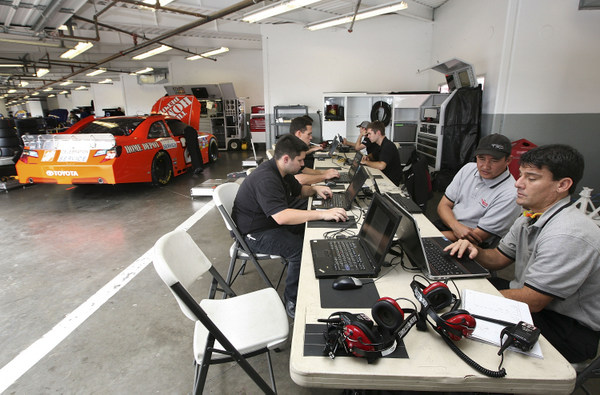
It takes a lot of engineers to run a NASCAR team these days. But is the racing really any better? (Photo: Getty Images for NASCAR)
The electronics in a NASCAR stocker is quite complex and sensitive. Gordon's Bristol problems, for example, resulted from a seemingly simple battery/charger swap-out that unexpectedly fried the $11,000 McLaren CPU.
The Gordon-EFI issue has been one of the most dramatic.
"We were able to get him a spare cpu to use," Kerr says.
Though not at Bristol....
"We want to help everybody out...but at the end of the day the teams are responsible for their own spares.
"However we were able to get him one to go racing with at California (the week after Bristol). It was a little bit of a take, but we got him one."
Where the buck really stops in this Gordon-EFI issue? Well, NASCAR's schedule of Daytona-to-Phoenix-to-Las Vegas-to-Bristol-to-California-to-Martinsville-to-Texas-to-Kansas is certain to test the mettle of anyone in this sport.
There is an increasing electrical demand by various pumps and gizmos in a NASCAR stocker, leading to ever more expensive battery and charging systems.
And the numerous electrical sensors an EFI setup requires are extremely sensitive. (Some drivers wonder how the extreme heat in a car during a three-hour race at 90-plus degrees may affect or degrade an EFI system.)
Then there is the never-ending quest by teams to cut weight in these stockers – a trend that begs for NASCAR to step in and reverse, since teams are spending exorbitant amounts on things as silly as carbon-fiber air ducts, to gain as much as 500 pounds of 'free' lead to play around with in the chassis. Saving money on thinner electrical wiring may be one reason for so many electrical issues the past year or so.
So when TV announced – as it did at Bristol in the Robby Gordon situation – that 'the problem isn't an EFI problem,' it is disingenuous.
EFI has forced teams to redesign significant parts of their cars, and that seems to be an issue that NASCAR executives have generally tried to ignore or sweep under the rug.
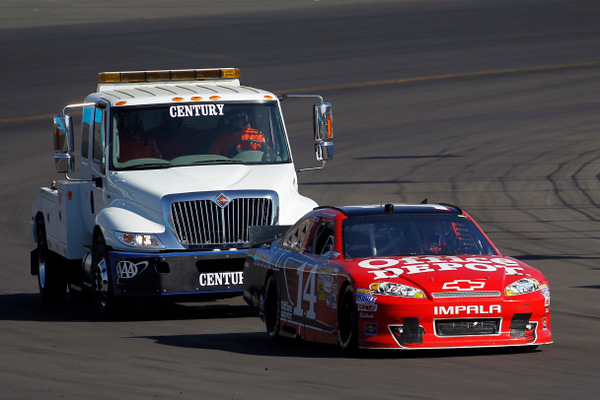
Tony Stewart needed a push down pit road at Phoenix, when his engine died, with an EFI problem (Photo: Getty Images for NASCAR)
However Kerr says the various engine specialists who have been working on the development of this specific NASCAR EFI don't have to come to the track anymore "because they are comfortable with the system, and there is nothing to be concerned about.
"It's just like anything new."
And this isn't really new to racing, just new to NASCAR.
Formula 1 has been using EFI for years, and electronic fuel injection systems have been in various racing series for a long, long time.
The F1 EFI is quite different from the NASCAR EFI, Kerr says. "The DNA of this NASCAR cpu came from the Indy Racing League cars.
"We were doing IRL, and there's no point in reinventing the wheel if you've got a good platform. So we used that IRL system as a 'cheat sheet' for NASCAR and designed this system around what NASCAR required."
However using the IRL for a model of anything much for NASCAR might be a stretch, and a run down the wrong road, considering how ragged the fortunes of the IRL at the moment.
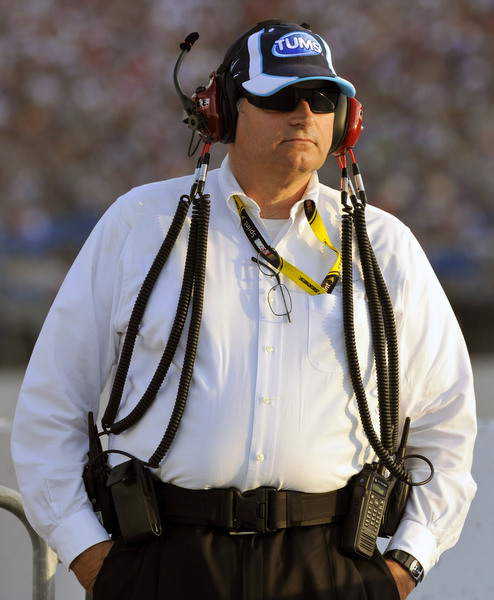
Cal Wells: when he brought computers into NASCAR, the sport changed dramatically (Photo: Getty Images for NASCAR)
NASCAR racing has had a reputation for keeping things as low-tech as possible.
Now people familiar with this part of the sport know well that NASCAR has really been high-tech for decades, despite the image.
Never quite as high-tech as this, however.
Certainly never as expensive. (And check the quarterpanels on these Cup cars to get an idea of how dry the financial barrels have become.)
So will this move to more visible high-tech be a boon eventually for this sport, as a positive for its image?
Good or bad, so far EFI doesn't appear to be any major game changer, looking at the overall playing field (though the Richard Childress camp appears to be a bit behind in all this).
And fans may not perceive much if any difference in the competition. "Hopefully it doesn't," Kerr says. "NASCAR is built around a 'level playing field.' We don't want to see somebody with a magical tuning 'map' to where they can lap the field.
"The (Detroit) manufacturers provide this sport with a lot of sponsorship dollars, and we need to be able to show them, the people who invest in this sport, that we are using technology from the cars they sell.
"That's one of the steps EFI helps us with."
And the expense of EFI, Kerr says, may be misplayed: "Before fuel injection, you could have teams with $4,000 or $5,000 carburetors. And you had two MSD (ignition) boxes (per car), at roughly $700 apiece, and you'd throw them away after eight races.
"What we have (with EFI) is something like $25,000 to $30,000 for a turn-key system."
Per car, with two cars per team at the track, and two cars back at the shop ready to be loaded for the next weekend's stop.
The McLaren cpu itself is $11,250. Electrical harnessing is about $8,000. Sensors, $3,000 to $4,000. Fuel pumps, headers....
The lifespan of a cpu? McLaren recommends each team sent them in for tuneups at the end of the season, for $750 each.
"But you're not going to have replace the cpus at the end of each season...."
Another question: Is this a mature technology? And, if not, then why not introduce it first on the Truck and Nationwide tours, to work out the bugs?
Kerr says that's easy to answer – Cup team owners are much better equipped with engineers and dollars to handle a major changeover like this.
"And we're 10 races into the season, through practice at Talladega, and nobody's come knocking at the door today.
"Mature? I don't want to get ahead of myself, but I think we're fairly close. Our B2B guys can kick back here in the trailer."
A good case presented here.
Still, bottom line, perhaps some of the 'golden rules' for this sport's bosses to have to answer, in such situations:
Is the racing better now?
Is the racing cheaper now?
Does this entice potential new team owners to come into the sport?
As far as EFI goes, at the moment the verdict still appears in doubt.
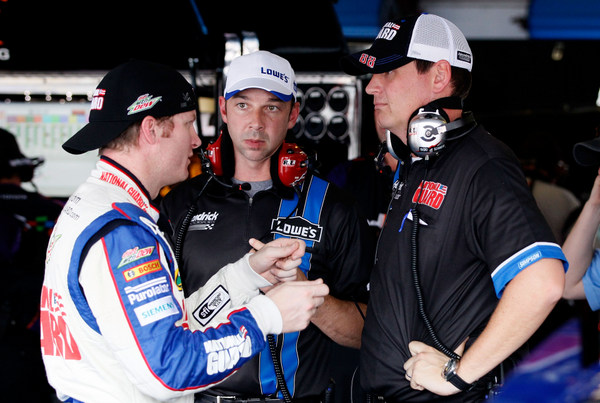
Dale Earnhardt Jr (L), here with Chad Knaus (C) and Steve Letarte, has expressed reservations about some aspects of NASCAR's new EFI project (Photo: Getty Images for NASCAR)
© 2010-2011 www.mikemulhern.net All rights reserved.
Web site by www.webdesigncarolinas.com







NASCAR, EFI, ETC....
Mike, Try this on....
The Nationwide series or LMS, goes to:
>only Mustang, Camaro, Challenger race cars built on stock platforms from the factory.
>A 300 C.I. max engine with a 4 barrel.
>No team is allowed to bring more than two cars and two engines to the track.
>No more than 9 crew members at track
>Runs events at Toledo, Madison, Rockford, Thompson, Pikes Peak, Road America, Mid-Ohio, Lime Rock, South Boston, Hickory, VIR, Road Atlanta and only runs 15 campanion races with CUP in a season.
>All stand alone events are 1 or at most 1 and half day events
>No promoter is allowed to charge more than 25 dollars a ticket
>no top 35, 43 fastest race.
I beleive we would start to see a real return to roots racing with a series that would be low tech and affordable and accessible.
Whadda ya think
David Pruitt
>any Cup driver in the top 25 in CUP points in not allowed to run more than 5 LMS races, any 5 he wants.
Reply to comment
Peeking Behind The Curtain...
Great Story with good historical references. No one mentions the little Teams that couldn\'t get EFI parts before Daytona because the fleets bought them all and the ARCA Teams that couldn\'t get non-EFI harnesses because the manufacturers ran out of capacity and materials.
Did they confiscate your spy camera at the Garage Gate? A picture of this innocuous trailer would add style to the story instead of all the stock images.
You walked right past the greatest untold Racing Business story of this decade. How entrepreneurial Crew Members like Butch Stevens, Tex Powell, Clyde Vickers, Banjo Matthews and many others created a vibrant and successful industry developing and supplying the parts and services which fuelled the explosive growth of NASCAR and then how that industry was impacted and consolidated by personal rivalries, generational changes and outside influences until it inevitably collapsed in the current economic strain on the Teams and, consequently, these suppliers.
EFI
Excellent article, Mike!
I think you have hit on the probable sources for the EFI teething problems, especially the more complex wiring harnesses and connectors.
I retired from the aerospace industry after many years as a project manager in DT&E. When we had protoype test failures, more often, than not, the fault tree traced back to an improperly-installed wiring harness, or connector. I think this is what NASCAR teams are stuggling with now. And it is no surprise that an enginnering-driven team such as Roush-Yates is slightly ahead of the learning curve with their adoption and integration of EFI.
More Problems At Talladega
This story got more legs with numerous engine and fuel problems in today's Winston 500, notably several cars running out of fuel many laps early.